Rajasthan Board RBSE Class 12 Biology Notes Chapter 18 Oil, Fibres, Spices and Medicine Producing Plants
The branch of botany which deals with the detailed study of economically important plants, their products and their improvement so that these plants may’become more productive and useful is known as economic botany. The basic requirements of human beings are food, feed, fibre and shelter.
All these are being fulfilled directly or indirectly by plants. Thus plants are wonderful gift of nature to mankind and provide almost every thing essential for life of huarnn beings and all other living organisms. Under the field of economic botany economically important plants are classified on the basis of the uses of their products. In this chapter, detailed description of four important types of economically important plants is given.
These are :
- Oil producing plants
- Fibre producing plants
- Spices producing plants
- Medicinal plants.
Oil producing plants
- Chemically fatty oils are complex organic compounds which are immiscible with water and remain in liquid (oil) or solid or semi solid (Fat) state at normal temperature. These are derived from different parts of plants such as fruits or seeds etc.
Two types of oils are found in plants-
- Aromatic, essential or volatile oils.
- Fatty, fixed or non-volatile oils.
Aromatic oils-
- These are volatile hydrocarbons having strong odour. These are derived through the process of distillation. Example- “Mogra”. Jasmine, Rose, “Khas-khas” etc.
Fatty oils-
- These are nonvolatile oils and ester of fatty acids and triglyceraldehyde alcohol (Glycerol). These are derived through mechanical extraction and not by distillation. Example-Edible oils (groundnut, mustard, soya bean, suflower etc.) and many non-edible oils (castor, ‘neenf, karanz).
![]()
Based on their behaviour when kept open in air, the fatty oils are categorised in to four types-
- Drying oil-Form a thin and delicate layer on surface when kept open in air. Ex. Linseed oil, soyabean oil “Kusum” oil.
- Semidrying oil-Form a thin layer when kept open in air for long time. Ex.-Cotton seed oil, “Til” oil, sunflower oil.
- Non-drying oil-These do not form any type of layer on surface even after prolonged exposure to air and remain in liquid form. Ex-Ground nut oil, castor oil, mustard oil.
- Fat or tallow-These remain in solid or semisolid state at normal temperature. Ex-Coconut oil, palm oil etc.
Mustard.
Common name – Indian colza (yellow mustard)
Botanical name – Brassica napus var. glauca (Brassica campestris var. Sarson)
Family – Brassicaceae (Cruciferae)
Useful oil yielding part-seeds.
Note-Many other varieties of mustard such as black mustard, brown mustard, “Rai”, black “Rai”, white “Rai” etc. are also economically important.
Origin & Production
1. History of use of mustard as spices is very old. Several species of mustard are believed to have originated in Asia minor- Iran, middle Asia, Himalayan region, and Mediterranean sea region. Mustard is mainly ‘Rabi’ crop.
2. It is sown during October-November and harvested during February March. It is cultivated mainly in the non irrigated areas and in irrigated areas at some places.
3. India occupies first place among the mustard producing countries. In India, U P. and Rajasthan are main producers.
4. In Rajasthan, mustard is extensively cultivated in Bharatpur, Alwar, Sawaimadhopur, Karoli, and other districts.
5. Besides U.P. and Rajasthan, Punjab, Bihar. Madhya pradesh are main states producing mustard.
Mustard plant
Mustard plant is annual, weak, poorly branched plant. It has tap root system. Stem is herbaceous, branched, erect, solid, cylindrical, nodes and intemodes are clear.
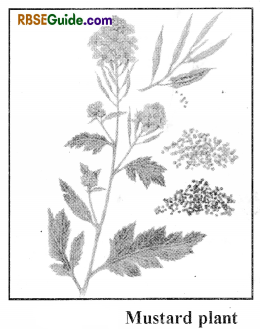
1. Leaf is simple, alternate, radicle or cauline. usually entire, sometimes lobed. petiolate. exstipulatc. reticulate venation, have strong odour. Infloresence is raceme or corymbose raceme.
2. Flower is ebracteate, pedicellate, usually actinomorphie. hermaphrodite, complete, regular, shiny yellowish is colour.
3. Fruit is siliqua or silicula.
4. Seeds are light yellow, oil containing and non endospermic.
![]()
5. Under normal conditions, production of mustard is 10001200 kg per hectare. Seeds contain 30-40% oil. which is extracted mechanically by oil mills and ghani’s (milling station).
6. Oil is heavy and bright yellow in colour. Strong and punjent odour of mustard oil is due to sulphur containing compound Allyl isothiocyanate.
7. This oil is non-drying oil and oil of some varieties is semi-drying type.
8. Typical fatty acid of this oil is Erucic acid. Other fatty acids are oleic acid and palmatic acid.
Improved Varieties
- For Rajasthan some of the varieties suggested arc Poosa Kalyani (Lotni Sarson), Vanina, Durgamani, RH-30 and TM-11. Tm-11 contains more oil contents than other varieties.
Economic importance
- One of the main edible oil which is used for cooking.
- Oil is also used for massage, as hair oil and for lighteing lamp.
- Husk of oil seeds after extraction of oil is used in the form of cake for cattle.
- Oil is used in manufacturing of soap and making rubber susbstitutes.
- Used as lubricant in machines.
- Used for softening of leather goods.
- Seeds used as spices and used in pickles.
- Leaves are cooked as vegetables.
Groundnut, Peanut
- Common name Groundnut (“Mung fair”)
- Botanical name—Arachis hypogect Family—Fa baceae (Legumino sae)
- Sub-family—Papilionatae
- Useful oil yielding part-Seeds.
Origin and Production
1. Centre of origin of groundnut is Brazil (South America) No wild species of this plant is known. Besides Brazil, six more secondary and tertiary centres of origin are known.
2. At present groundnut is commercially produced in temperate and tropical region of world. India is first in production and China is at second position in terms of groundnut production. Nigeria is biggest exporter and France is biggest importer. ,
3. Gujarath,Maharashtra, Andhra Pradesh. Tamilnadu and Karnataka are main Indian states producing peanut.
Plant
1. Plant of groundnut is semi erect or spreading and branched annual herb. The tap root system harbours Rhizobium bacteria in the root nodules.
2. The leaves are pinnately compound containing four leaflets.
3. The flowers are typically papilionaceous type. The flowers develop on the positively geotropic carpophores arising from the base of stem.
4. After pollination the carpophore enters into soil hence the fruit is formed underground. This feature is called geocarpic Groundnut shows self pollination. The fruit of groundnut is indehiscent lomentum and contains 1-5 seeds.
5. The cotyledons contain 43-55% oil and 25-28% protein.
6. Groundnut is grown during rainy season as “Kliarif ‘ crop.
![]()
7. The crop matures in 100-130 days. Hybrid varietives produce 10-15 quintal per hectare. 100 kg (one quintal) groundnut pods yield about 70-75 kg seeds.
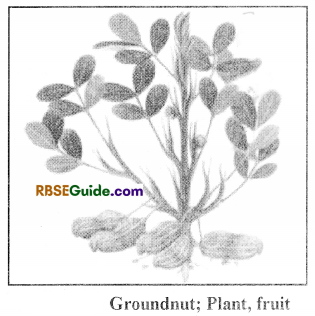
Properties of Oil
Groundnut oil is non drying edible oil. Colour is bright yellow and with good odour Oil contains fatty acid oleic acid in maximum amount (56%). Besides this there are lmolenic acid (25%). palmatic acid (6-12%) and aracidic acid also. It contains phosphorous and vitamins (Thiamine. Riboflavin, Niacine) in sufficient amount.
Improved Varieties
Suitable varieties for Rajasthan are RS-1. RSB-87, AK-12,24 MA-10, Chandra. Girnar.
Economic Importance
- Seeds of Groundnut are highly nutritious and eaten raw or as roasted. One pound of groundnut contains 2700 Calorie energy.
- Oil is mainly used for cooking as well as for frying.
- Hydrogenation of oil is done to form vegetable ghee.
- After taking out oil. husk of oil seeds is used as nutritious cake for cattle,
- Oil is also used for making soap, and in cosmetics.
- This is also grown as alternating crop in crop rotation and as mixed cropping due to presence of Rhizobiitm bacteria in root nodules.
- Synthetic fibre Ardil is made from it’s protein.
- Toxicity of certain pesticides such as rotonin, nicotine can be increased by mixing this oil.
- Good quality cake of groundnut can be used as protein supplement after grinding.
Coconut
- Common name- (Coconut- “Kliopra”)
- Botanical Name—Cocos nucifera
- Family—Arecaceae or Palrnae
- Useful oil yielding part—Endosperm
Origin and Production
1. There arc three views of scientists on origin of coconut. According to one view, it originated in North Andes. Second view states about origin in areas of southern and central America and third view is that it originated at any place of South-East Asia.
2. The coconut palm is grown in coastral areas of humid tropical climate. Important countries producing coconut are-Indonesia. Phillipines, India, Tanzania. Kenya. Bangladesh. Srilanka, Papaua, New Guivania etc. Although m last century India was first among coconut producing countries of world but now has come down to third position. Indonesia and Phillipines are on first and second position.
![]()
3. In India, Kerala is main producer of coconut and accounts for 46% of total production in this country.
4. Besides this, it also grows in Tamilnadu. Karnataka, Andra Pradesh. Goa, Daman & Orissa. Maharashtra, Gujarat and West Bengal. In Rajasthan it is not produced at commercial level.
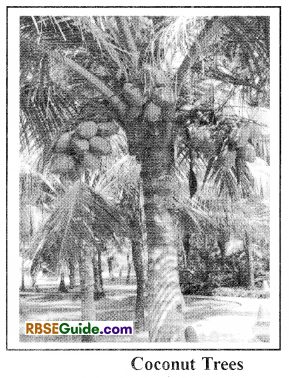
5. The generic name Cocos is derived from a Portuguese word Coco which literally means monkey, as the fruit of coconut resembles with the head of monkey.
6. The species name nucifera means nut bearing.
7. This plant is a novel gift of nature to human. All parts of this plant are useful for men in different form. After cotton this is second important plant which provides both important edible oil as well as fibres in high amount. On account of this, it is called as Wonder plant.
Plant
1. Coconut plant is a tall tree approximately 10-24 meters long and is normally unbranched. Main trunk is long, straight, thin with leaf scars on .the surface. A crown of very large sized (2-6 meters long) leaves is borne at the top. The leaves are paripinnately compound and number about 30-40 in a crown.
2. The mature coconut plant bears compound spadix inflorescence. The flowers are unisexual and the plant is monoecious.
3. Each branch of the inflorescence produces 30-40 lateral branches and on each branch 15-20 fruits are formed.
4. After fertilization, fruit ripening is completed in about one year.
5. Coconut fruit is drupe with three layered fruit wall. The epicarp is thin and smooth, the mesocarp is fibrous and the endocarp is hard and woody in nature.
6. The commercial fibre named as coir is obtained from the fibrous The coir is used in making cushions and mattreses.
![]()
7. Inside the stony woody endocarp is present, the oily endosperm, which in common language called as “Giri”, “Khopra” or “Chittak”. Oil is derived from this only.
8. The mature endosperm contains 60-70% fatty acid. Initially endopsperm is in liquid form within the endocarp and called as coconut milk which is highly nutritious and used as drink.
9. Fruits are produced round the year. Oil is extracted from mature endosperm of coconut by different methods.
Qualities of Oil
Coconut oil in pure form is colourless or very light yellow in colour and it is liquid at above 23-24°C and below this as semisolid or solid. Main fatty acids present are loreic acid (44-51%), myristic acid (13-18.5%) andpaimatic acid (7.5-10.5%) This oil is non-drying type.
Improved varieties
- Anadaman General, Anand Ganga, Chandralakshay and VHC-1.
Uses of Oil
- Extensively used as cooking oil.
- Many food products are formed from oil and giri such as margarine (artifical butter), candybar, sweets and biscuits.
- Hydrogenation of oil leads to formation of vegetable ghee.
- Most commonly used as hair oil. Many cosmetic products such as bath soap, shampoo, cream, shaving cream etc are prepared from it.
- Husk left after extraction of oil, “Poonac” is an ideal animal food.
Other Uses
- It is an important material in religiouns, cultural and marriage ceremony.
- Toddy is being derived by causing a wound on inflorsecence. Toddy is further used to make sugar.
- Mesocarp of fruit is used to form coir fibre, which is used to form ropes, brush, broom and mattreses.
- Coconut milk is ideal and nutritious drink.
- Stem of coconut is used as supporting woody columns, leaves are used in making roof and charcol is made from woody stem.
Castor Oil Plant
- Common name- “Arandi”
- Botanical name—Ricinus communis ‘
- Family—Euphorbiaceae
- Plant part used for oil yielding—Endosperm
Orign and Production
- Castor plant has originated in India and North Africa. It is mentioned also in “Sushruta Ayurveda”.
- Now this is grown in countries having tropical and subtropical climatic conditions.
- Major producer countries are Brazil, India, Russia, Argentina and other countries such as China, Thailand, Sudan etc.
- In India it is grown in states of Andhra Pradesh. Gujarat, Karnataka, Madhya Pradesh, Orissa and Rajasthan. Sirohi district probably is maximum producer of castor in Rajasthan.
Plant
1. Castor plant is long, annual, weak, green and small plant 2-3 metres in length. Some dwarf varieties are more popular. Stem is weak, coloured, mostly hollow branched and glabrous.
2. The leave are green-greyish red simple, plamately lobed with muticostate reliculate vention and contains watery latex.
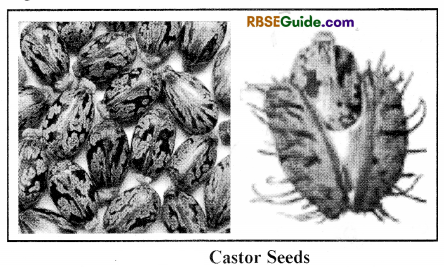
3. Inflorescence is branched raceme having unisexual flowers.
4. The plants are monoecious. Both male and female flowers are present in the inflorescence with male near the basal region and female towards the upper side.
5. In male flowers 5 stamens are present which are branched.
6. The female flowers are relatively few in number. The gynoecium is tricarpellary syncarpous and trilocular. Each locule bears one ovule and hence one seed is formed in each locule.
![]()
7. The fruit is Regma which dehisces at maturity and splits into three parts, each part having one seed.
8. The seed coat is hard but smooth, variously spotted and has a corky out growth called as caruncle.
9. There are two papery cotyledons surrounded by the massive, fleshv. oil containg endosperm in side the seed coat.
10. The seeds are cndospcrmic and oil is extracted from the endosperm only.
11. The plant is sown during rainy season and the crop produce is obtained in 9-12 months.
Properties of Oil
- Castor oil is non drying oil. colourless, or light yellow or green, non soluble in petroleum ether and viscous.
- It contains risinolic acid (91 -95%) in maximum amount. It also contains lmoleic acid (4-5%) and very little amount of palmatic acid and stearic acid as fatty acid.
Uses of Oil
- Fatty oil of castor is cathartic and lubricant. It is a mild purgative used for treatment of constipation. Purgativ e effect of oil is due to risinolic acid.
- Used in making transparent soap and tooth paste.
- Used as lubricant in machines and aircrafts.
- Although oil is non drying type, after making alternation in it’s property, it can be used for making paints and varnish.
- Grease, polish are made by hydrogenation of castor oil.
- This oil is also used in making pesticides.
- Husk is used as manure and pesticides.
- Used in manufacturing artificial leather, oil clothes and plastic.
Fibre Producing Plants
- Plant fibres are used for fulfilment of human requirements.
- From economic point of view fibre producing plants are important just next to food crops.
- Out of three basic requirements of human, clothes are second basic requirement.
- From ancient time, plant fibres were used by men to cover their body. In comparison to plant fibres animal fibres such as wool, silk and fur have limited use.
Types of Fibres
Plant fibres are obtained from various parts of plant body. On the basis of their origin and structure, plant fibres are of three types.
- Surface Fibres: These are produced as outgrowths from plant parts such as seed or surface of fruit.
- Soft, Stem or Bast Fibres : These originate from phloem fibres of stem of dicotyledonous plants. These are special type of narrow, elongated and lignified cells. Example : Jute, Hemp and Patsan.
- Hard or Leaf Fibres : These are derived from leaves of monocotyledonous plants such as-Moonj, aera, patera.
Classification of Plant Fibres :
Note : Economic botanist A.F. Hill (1952) classified plant fibres, in six groups on the basis of their utility.
- Textile Fibres : These fibres are used to make clothes, ropes, fibre strings (sutli), cloth bag (Sack) etc.
- Brush Fibres : These fibres are used in making brooms, brush etc. Example : Leaves of palm tree (Khajur tree).
- Plaiting and Rough Weaving Fibres : These fibres are used for making basket, mats, caps, seats of chairs etc. Example : Bamboo.
- Filling Fibres : Used to fill mattresses, in making blankets and pillows etc.. Example : Cotton, Madar, Semal, Coir (Coconut) etc.
- Natural Fibres : Used directly for covering body. Example : Broussonetia papyrifera. It’s bark is used to prepare tapa cloth.
- Paper making fibres : Used to make paper, cardboard etc. Such as Bamboo, Eucalyptus, Certain grasses, Populus alba.
Munj
- Local name—Munj, Sarkenda
- Botanical name—Erianthus munja
- Synonym—Saccharum munja
- Family—Poaceae (Graminae)
- Economically important Plant Part—Leaves for fibres
Plant
- Munj plant is monocotyledonous, perennial dense grass which generally grows in arid and sandy area and is grown in desert and river banks to stop soil erosion.
- Length of grass plant may be 5-8 feet.
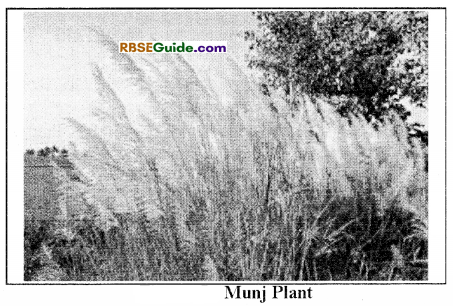
- Roots and underground part is thick and broad.
- In rainy season the plant becomes green and becomes leaf less at the end of winter season. Leaves fall when they dry.
- Stem is unbranched, thick in size like chalk stick, smooth, solid, with distinct nodes and intemodes. Stem is used to make sitting base (“mudde”) and chick (curtain). Leaves are very large, broad and have sharp margins. Leaves have unicostate parallel venation.
![]()
Fibre
- In the middle of winter seasons, leaves are cut and dried by making bundles.
- Stem is also cut and kept for various uses.
- The leaves are hammered with wooden hammer and fibres are obtained.
- Fibre of munj is thick, rough and uneven.
- Thin ropes are made from fibres. Munj fibres are used to make base of bed (“Charpai” or “Khaaf’), mat (“Chatai”) etc.
Cotton
- Common name- “Kapas”
- Botanical name—Gossypium sp.
- Family—Malva ceae
- Economically important plant part—Fibres present on surface of testa of seeds.
Seeds for oil fatty oil (Binola oil)
Varieties of Cotton
There are many varieties of cotton, but following four species are cultivated at commercial scale.
1. Gossypium hirsutum : Orgin is new world or America. It is also caleld as Upland cotton. It is extensively cultivated all over the World. Its fibres are thin, white and long.
2. Gossypium herbaceum : It has originated in Africa of ancient world. It is extensively cultivated in India, Iran. China. Russia etc. Fibres are of medium quality. This is also called Uppam Cotton.
3. Gossypium arboreum : This is also called desi cotton (Asiatic cotton). It probably originated is Indo-China, It is cultivated in India, Myanmar, Malaysia, China. Taiwan. Fibres are thick but short in length.
4. Gossypium barbadense: It probably originated in South America (Brazil) this is also called Egyptian cotton. On the basis of quality of fibres, this is the best cotton. Fibres are used in manufacture of waist wears (innetwear), hosiery items, towels and making soft clothes.
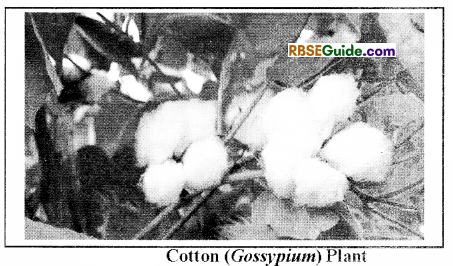
5. Quality of cotton fibres depends on many factors such as strength, length, number of twists, fineness, colour, shine, counts, nappvness and ginning percenta ge etc,
6. India, I SA. Russia, China, Brazil, Egypt. Pakistan. Turkey, Mexico and Sudan are major cotton producing countries of World.
7. In India it is mostly cultivated in Maharashtra. Gujrat, Karnataka, Madhya Prades, Punjab, Rajasthan. Uttar Pradesh and Tamilnadu,
Note : During ancient period, India was main centre of production of cotton and cotton related products. The world famous “Dacca Muslin” was produced in India.
Plant
1. Most agricultural varies of cotton are annual.
2. Sowing of cotton is done during April to July and it’s collection is done during October to March.
3. The plant is 2-6 feet long.
4. Stem is erect, unbranched, woody and brown coloured.
5. The leaves are palmately lobed. The flowers are large.
6. pedicellate, with three large bracts.
![]()
7. The petals are normally large yellow, twisted.
8. The flowers are bisexual with infinite stamens which are monadelphous. The ovary is superior with two or more locules.
9. Fruits are loculicidal capsules. Young fruits are called bolls.
10. The seeds are oval, brown and posses long, fine white fibrous outgrow ths on the surface of outer seed coat (testa). These form the commercial fibre and called lint or staple.
11. Along with lint, small fibres are also present and are called
12. Chemcially, the lint is mainly cellulose (94%) and protein (1.3%) along with some other components.
Improved Varieties
- Several high yielding varieties of cotton have been developed by Cotton Technological Research Laboratory (CTRL) Matunga (Maharashtra) and Central Institute for Cotton Research (CICR) Nagpur (Maharashtra). Some of these are as follows-
- MCu-2, 3; AK-277; Sujata; Mahalaxmi; Varahlaxmi etc..
Uses of Cotton
- Cotton clothes, blended clothes, hosiery items are manufactured.
- The cotton fibres are almost pure cellulose and hence used as raw material in cellulose industry.
- Used in making blankets, ropes, and floor spread sheets (“Danyna”) & in tyre industry.
- Filling fibres in pillows, cushions, mattress, quilts etc.
- Llsed as absorbent cotton, making bandage etc.
- Cotton seeds are source of semidrying cotton seed oil.
- The cake left after crushing of seeds in nutritious fodder for cattle.
San, Sunn, Sunhemp
- Botanical name : Crotolctria juncea
- Family—Leguminosae / Fabaceae
- Sub-family—Papilionatae
- Useful plant part—Bast fibres from stem
In India, Sunn is cultivated since ancient time for its fibres and green manure.
Although its origin is not certainly known, but some scientists believe that it might have originated in Indian subcontinent.
It is cultivated at large scale in Asian and African countries.
In India it is grown at large scale m Andhra Pradesh. Tamil Nadu and Madhy a Pradesh and at normal scale in other states.
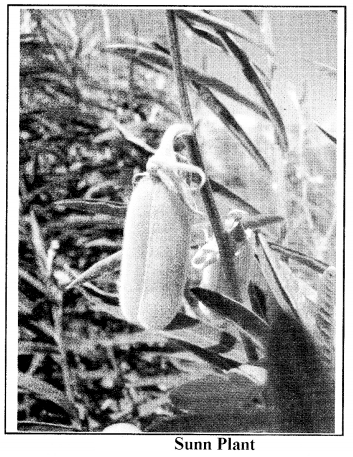
Plant
- Sunnhemp plant is l .5 metre long annual plant.lt is grown in rainy season. In four months, crop is ready for harvesting.
- Sunn fibres are obtained as bast fibres from stem of Sunn plant and fibres are separated from stem by process of
Retting
- During this process bundles of fully mature plants are kept in water for 5-7 days for rotting.
- This rotting is done by a bacterium, Clostridium
- After this the fibres are pulled out from stem and after washing and drying, put in bundles.
Uses of Fibres
- Twisting of Sunn fibres is done to form ropes.
- Thin ropes, canvas, bags, fish trap nets are made from these fibres.
- Immature fibres are used to make cigarette paper and tissue paper.
- Whole plant is used as green manure.
- Gum obtained from seeds is used in printing / dyeing industry.
![]()
Spices Producing Plants
1. The history of relationship between human and’spices is very old and intersting.
2. In ancient time men were having strong desire towards spices just next to gold.
3. In that period, the international trade was done mainly of these products.
Note : According to A.F. Hill (1952), the essential oil containing dry and hard parts of plants which are normally used in powder form are called spices.
4. The spices are generally called as food adjuncts. These are not important as nutrient elements and source of energy because their, calorie value is very low but their use make the food tasteful.
5. Addition of spices makes the food items fragrant, more nutritive and digestable as they promote secretion of gastric juices and help in proper digestion and assimilation.
6. In India, spices are obtained from several plants. In Rajasthan also many spices producing plants are grown. Some of the important spices grow n in India are : Clove (.Syzygium aromatium), Fennel (Foeniculum vulgctre), Red Chillies (Capsicum annum). Black pepper (Piper nigrum). Cumin (Cumimtm cyminum), Lovage (Trachyspermum ammi). Coriander (Coriandrum sativum). Turmeric (Curcuma longa). Ginger (Zingiber officinale) etc.
Clove
- Local Name – ’Long’
- Botanical Name—Syzygium aromaticum
- F amity—Myrtaceae
- Useful plant part—Dry floal buds.
1. Clove is a native of a small island known as Moluccas. Clove plant is a medium sized (12— 15 meters), branched, evergreen, beautiful tree.
2. The dark red coloured flowers are borne in a compound raceme inflorescence.
3. The floral buds are cylindrical, nail like conical and have fleshy base.
4. Clove is derived by drying these unopened or semiopen buds.
5. Tanzania produces largest amount of clove in the w orld Other major clove producing countries are, Zanzibar. Medagaskar and Indonesia. It is also grown in India. Srilanka and Malay asia.
6. In India it is grown in Tamilnadu (Kanya Kumari and Nilgiri moutain range) and Kerala (Kottayam and Quilone)
7. Strong and pleasant odour of clove is due to presence of volatile oil euginol upto 13.2%.
8. Clove oil is extracted from the floral buds by steam distillation process.
Uses
- Clove is used as spices to incorporate sweet and pleasant odour in the food products. It’s hot nature and pleasant odour makes it an important gradient of “Gann masala” (spicery).
- It is stimulant and carminative. It is used in indigestion and abdominal pain.
- Clove oil is used in making toothpaste, soap, cosmetic products, backery products, pickels. and syrups etc.
- Used in treatement of pain in teeth, inflamation of gums etc.
- Used as ingradient in cough syrups, skin lotions and many Ayurvedic formulations.
- In Indonesia, it is consumed in large quantity in smoking tobacco named as Kretek.
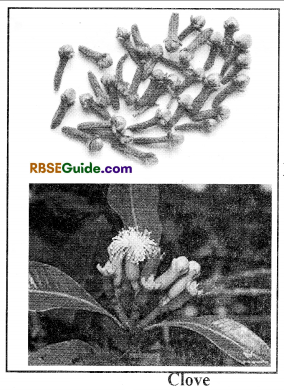
Black Pepper
- Local Name- “Kali Mircli”
- Botanical Name : Piper nigrum
- Family—Piperaceae.
- Useful plant part—Unripe, dry drupe fruit.
Origin & Production
1. Place of origin of black pepper is South India and Indo- Malaya region. Among spices, black pepper is exported in largest amount from India. Hence, black pepper is called king of Indian spices. India and Indonesia are largest producers of black pepper.
2. In India, Kerala is the largest producer of this spice. It is also grown in Karnataka. Andra Pradesh. Aasam & Bengal.
3. The plant of balck pepper is a weak stemmed perennial climber which twins around the columns and rises up.
![]()
4. The leaves are simple, alternate, oval, broad large sized and with bitter taste.
5. The inflorescence is catkin and contains 50-100 minute unisexual flowers:
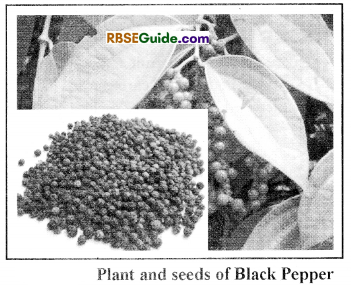
6. The fruits arc spherical single seeded drupe which are bright red when unripe. They become wrinkled and black on drying.
7. After removing the black fruit wall, while seeds are obtained which are sold by the name white pepper. The taste of black pepper is bitter and its odour is very strong.
Uses
1. The fruits of black pepper contain starch (28-49%). aromatic oil (1-3%). fibres and small amount of alkaloids. The aromatic oil pinean a. b. and the alkaloid pipel ine impart strong odour and chillatastc to this spice.
2. Black pepper is extensively used as spice and medicine.
- Used in edible preparations, \egetables to make them digestive.
- It is carminative and stimulates secretion of saliva and digestive juices.
- It can be used as powder mixed with pure ghee to improve eye vision.
- Used m preparation of drinks (“Thandai”). in making sauce and “Chutnex “.
- With mint, ginger and sugar candy the decoction is used to give relief in fever, cough, cold, sour throat etc
- Meat is preserved by using black pepper.
- Used as an important ingradient in several Ayurvedic powdery formulations
Turmeric
- Local name- “Haldi”
- Botanical Name :Curcuma longa {Curcuma domesrica)
- Family : Zingiberaceae
- Important Plant Part—Dried underground Rhizome
Origin & Production
- Turmeric originated in south Asia. The mam producing countries are India. China, Indonesia. Sri-Lanka and West Indies. India is largest producer and also consumer of turmeric.
- In India Andra Pradesh is largest producer of this. Besides this in Tamilnadu. Maharashtra. Bihar. Kerala. West Bengal and Orissa also, turmeric is grown extensively.
Plant
1. Turmeric plant is annual or perennial herb.
2. The underground modified rhizomatous stem is well developed. It grows horizontally and produces clustured branches which are elliptical or cylindrical.
3. The leaves formed on 1-1.5 meter tall aerial stem are quite large, broad and have parallel venation.
4. The inflorescence is spike with yellow coloured flowers. Fruit is capsule.
![]()
5. Fresh rhizomes are cleaned and dried by proper devices (curing) and dry turmeric rhizomes are derived.
6. The yellowish orange colour is due to presence of curcumin and the musky (Kasturi) odour is due to presence of aromatic oils such as zingiberine, sesquiterpene, turmeric oil etc.
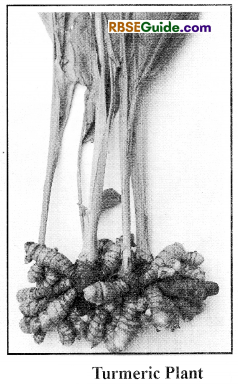
Uses
- Turmeric is extensively used as spice and medicine. It is used as spices in vegetables, pickles, butter, cheese etc.
- As medicine, it is effective blood purifier. It is carminative and antispasmodic.
- It is extensively used in treatment of external as well as internal injury.
- It is used in skin diseases and as ingradient in cosmetics.
- As dyeing agent it is used to dye cotton, silk and wool fibres.
- Used as sacred material in many religious and cultural rituals.
- Useful in curing cough, cold and asthama.
Chillies
Local name- “Mirch”- Red pepper
Botanical Name—Capsicum annum
Family—Solanaceae
Useful plant part— Unripe green capsule fruits (Vegetables) Ripe red capsule fruits (spices)
Origin & Production
1. Centre of origin of chillies is tropical America and West Indies. In India it was introduced very late, (probably in 17th century).
2. Except cold regions, presently it is cultivated in all parts of world such as India. Africa, Japan. Mexico. Turkov and U S.A.
3. In India, it is extensively cultivated in Andhra Pradesh, Maharasthtra. Karnataka. Tamilnadu. M.P, Punjab. Bihar and Rajasthan.
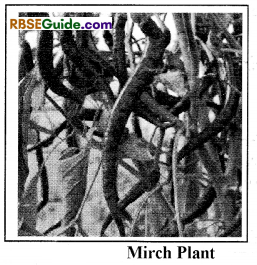
Plant
- Chilli plant is annul herb, and T-3′ tall. The leaves are simple, oval and bear white coloured solitary flower in their axil.
- The fruits are long, cylindrical many seeded berry.
- The tender unripe fruits are green coloured but on ripening become bright red coloured.
- The fruits contain a volatile, pungent and tangible compound capseisin and diffent amount of vitamins, proteins carbohyrates and other substances
- The red colour of the chilli fruit is due to presence of capsenuhin. capsorubin etc and carotene and lutein. There are many varieties of chillies in use such as sweet pepper, bel pepper, peprica. tabbesco etc.
- Shimla mirch is a different species known as Capsicum frutescens and is used as salad.
- Chilli plant is cultivated mainly in winter season but some varieties are cultivated round the year.
- The ripened fruits are dried and powdered to obtain commercial chilli powder.
Uses
- Powdered red chilli is one of the major spices. It is used mainly in vegetables, namkin. ketchup, chutney and pickles.
- Chilli is stimulant and carminative. It is also used in treatment of flatulence.
- Chilli tincture is used as gargle in treatment of Pharyngitis.
- Externally the paste of chilli powder is used in treatment of Waist pain. Nerve pain. Arthritis and Boil or sore caused by plucking of hair.
- Unripe Green fruits are used as Salad and in green sauce (‘‘Chutney”’). ‘
Fennel
- Local name- “Sonf
- Botanical Name—Foeniculum vulgcire
- Family—Apiaccae (Umbelliferae)
- Useful plant part— Mature Cremocarp fruit.
Origin & Production
- Centre of origin of fennel is mediterranean sea region. It is extensively grown in several countries such as India, Morocco. Egypt. China etc.
- In India, the main states producing fennel are Maharashtra. Gujarat. Rajasthan. U P. and Karnataka etc.
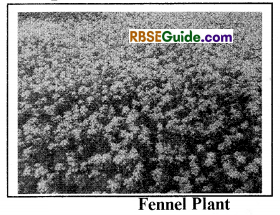
Plant
- Fennel plant is a tall, branched herb or small shrub having strong odour.
- The leaves are repeatedly dissected in to small narrow segments and have broad leaf base.
- Inflorescence is compound umbel containing large number of small sized greenish yellow flowers. The whole inflorescence may be of 20 cm diameter.
- The fruits are elliptical or oval green coloured and have stripped surface. It is schizocarpic cremocarp which splits in to two mericarps. The number of strips on the surface is usally five.
- Aromatic oil ancthol and fenchone (1-6%) along with semidrying fixed oil (12-18%) are present in the fruits.
- It is grown in winter season.
Uses
- Fruits are used as spices in pickles, biscuits and in other preparations.
- Sweet smelling oil is used to add essence or scent in soap. Ayurvedic syrups and drinking syrups.
- Femiel is carminative and stimulant. Used in treatment of stomach pain and hook worm in young babies.
- Used m flatulence and arthritis.
- Used as mouth freshner.
- Used as ingradient in-chewing betel.
Coriander
- Local Name- “Dhaniya
- Botanical Name—Coricmdrum sativum
- Family—Apiaceae. (Umbel lifcrac)
- Important plant part—Mature Cremocarp fruits and Tender shoots.
Organic in & Production
- Centre of origin of coriander is Mediterranean region. It is cultivated in Russia, hidia, Morocco. Poland. Romania and U.S.A.
- In India, the main producer states are M.P., Maharashtra, Rajsthan, Tamilnadu. Katnataka and Bihar.
- In Rajasthan, maximum cultivation of coriander is done in Baran, Kota and Jhalawar.
Plant
- The plant is an amiual herb having strong odour. It is cultivated for its foliage and the fruits. The plant is 2′-3′ long having hollow weak and branched stem.
- Lower leaves are less disselted whereas the leaves on the upper side are multipinnate.
- The inflorescence is compound umbel. The flowers are small sized and white coloured.
- The fruits are cremocarp with two mericarps. On the surface of fruits ten longitudinal straight stripes are found and alternating with the straight stripes ten wavy strips or costae are found.
- The fruits contain aromatic oil coriandrol (1.0%) and dark brown nondrying oil.
- Coriander is normally cultivated in winter season.
Uses
- Coriander powder is main ingradient used in vegetables, chat etc.
- Used in preservation of different drinks (Gin), products of tobacco, and other edibles.
- The fruits are stimulant, carminative and strengthen abdomen and heart.
- The tender green leaves are chopped and used in flavouring and garnishing the cooked vegetables.
- Green leaves are used in preparing green sauce which is used in several forms as an adjunct.
![]()
Cumin
- Common Name- “Jeera”
- Botanical Name—Cuminum cymimim Family—Apiaceae (Umbelliferae)
- Useful plant part—Dry Ripe cremocarp fruit.
Origin & Production
- Cumin is belived to have originated in Levant state of Mediterranean region. It is cultivated in Iran, India. Morocco. China. Russia, Indonesia, Japan and Turkey.
- Iran is largest producer and exporter country of Cumin.
- In india it is cultivated at commercial scale in Punjab and Uttar Pradesh (U P.)
Plant
- Cumin plant is mall, normally unbranched annual herb having slender and glabrous stem. The leaves are long, pinnately (Uni or bi) compound and dissected in to fine segments.
- Inflorescence is compound umbel with small light purple coloured buds and white flowers.
- The fruit is long, oval, cremocarp which splits into two mericarps. On the surface of fruit there are five prominent primary’ and four secondary stripes.
- Fruits contain 4.0% atomatic oil known as cuminaldehyde and 10.0% light coloured nondrying fixed oil.
- Cumin is cultivated as rabi crop.
Uses
- Cumin is used in inducing fragrance in vegetables.
- Roasted cumin powder is used in adding essence in curd preparations, in drinks (Jal Jira) and also as ingradient in many Ayurvedic powders.
- It is stimulant and carminative and used in treatment of flatulence and diarrhoea.
- The aromatic oil is used in perfumery and inducting essence in soups and syrups.
Lovage, Bishop’s Weed
- Common Name- “Ajwayan”
- Botanical Name—Tachyspermum cimmi
- Family—Apiaceae (Umbelliferae)
- Useful plant part—Mature dry cremocarp fruit.
Origin & Production
- Lovage is believed to have originated in Europe, Asia and north Africa.
- In India it is grown in Madhya Pradesh, Andhra Pradesh Gujarat, Maharashtra and Rajasthan.
- Plant of Lovage is an erect, weak, 1′- 1 .5′ long, branched perennial herb, with aromatic adour. The leaves are multipinnately compound. Inflorescence is compound umbel and bears small white or light blue flowers.
- The fruits are small, rough, curved cremocarp.
- The fruits contain volatile oil.
Uses
- The fruits are carminative, stimulant and enhance immunity. Hence used in abdominal ache, joint pain, cough and asthama etc.
- Thymol essential oil is extracted from the fruits and it is used in making balm, cream, soap etc.
- The fruits are used as spice in making biscuits and many fried edibles.
- After child delivery, the lovage is given to the women in various forms to strengthen the immunity system.
- The growth during winter season as rabi crop.
Medicine Producing Plants
1. The history of use of plants as source of medicines is as old as the human civilization. In prehistoric time the evil spirits or ghosts were considered as cause of diseases and accordingly for their irradication some hallucinogenic substances were applied.
2. Rigveda (1100BC) is propably the oldest book in which description of medicinal plants is included. Ayurveda written 3000 years back is an authentic ancient Indian “Grantha” in which human diseases, health and medicines have been described. The “Charak Sanhita” and “Shushruta Sanhita” written by Ayurveda experts (Ayurvedacharyas) are the basic ancient documents of medieianl plants. In France and Europe also important herbals were complited in 15th Hippocrates (460370 BC) is considered as Father of Medicine.
![]()
3. Medicinal plants are important on account of the presence of various chemical substances such as alkaloids, glycosides, tannin, resin, volatile oils, mucilage, gum etc. contained in their parts. These substances are stored in different parts of the plants such as fruits, seeds, bark, leaves stem etc. It is important fact that most medicinal plants are wild and only some plants are grown for obtaining medicines. Most Ayurvedic, Homoeopathic and Unani medicines are derived from plants.
- Local Name- “Chota chand” “Medicine of Mad” Botanical Name—Rauvolfla serpentina –
- (Rauwolfla serpentina)
- F amily—Apocyanaceae
- Useful plant part— Dry roots and bark of roots.
Origin
- Rauvolfla has it’s origin in India. This plant is also found in other countries such as Bangladesh, Sri Lanka, Myanmar (Burma), Thailand, Indonesia, Malayasia and Africa.
- In India it is commercially grown in Assam, Tarai regions of Uttar Pradesh and Himalayas, in Andrha pradesh, Kerala, Maharasthra etc.
- It does not grow in Rajasthan
Plant
- It is evergreen, perennial shrub which normally attains height of 60 cm. The roots are tuberous and spiral (like snape). wrinkled and rough with pale brown colour.
- The fresh roots smell like snake and are shaped like snake hence the plant is also called as snake root.
- Leaves are small, whorlcd and large spear shaped.
- Inflorescence is racemose with small white or light pink coloured flowers.
- The fruit is single seeded capsule.
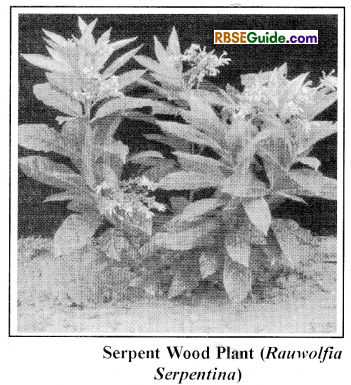
- The medicine is obtained from snake shaped tuberous roots and their bark. 3-4 years old shrubs are chopped in winter season and arc dried.
- Rauvolfia paint contains about 80 (eight} ) types of alkaloids. The bark of the root contains 90% of these alkaloids.
- The main alkaloids found in the bark arc Reserpine (Most important). Reserpinine, Serpentine, Ajamaline, Ajamalinine, Rauwolfinine etc
Uses :
- It is an effective remedy for insomnia, hysteria, and hypertension and is used in intense mental derangement (Psychosis). Hence it is known as medicine of mad.
- It is used as antitoxin in snake, scorpion and poisonous insect bite.
- Rauvolfia preparation induces contraction in the uterus and hence given to the pregnant women to ease the child birth.
- It’s decoction is beneficial in sentry, diarrhoea, and abdominal ache.
- Decoction of Rauvolfia bark is anthelmintic.
- Some medicines derived from serpent wood are available in the market, such as Serpina tablet, Sarpgandha tablet, Ghanvati, Sleep pills etc
Opium
- Local Name- “Afeem”
- Botanical Name—Papaver somimferum Family—Papa vcraceae
- Useful plant part-—(i) Latex of unripe capsule fruits,
- (ii) Seed- (Popp}’ seeds)- Postdana. Kliaskhas.
Origin & Production
- Opium plant is native of Asia minor. Presently it is cultivated in several countries. Such as Australia, Czechoslovakia. Myanmar (Burma). Hungary, India. Pakistan. Iran and Turkev etc.
- In India it is grown during winter season. Main states producing opium are Madhya Pradesh. Rajasthan, U P. and Bihar.
- In Rajasthan it is grown in the south east districts such as Chittoregadh. Banswada. Doongarpur and Jhalawara.
- It is cultivated under control of the state Government.
- Opium is collected from the unripe capsules during month of Feb-April,
Plant
- The poppy plant is an annual herb. The stem is erect (1’—3′ tall), unbranched and greyish green coloured.
- Leaves are large, alternate, lobed and sessile, inflorescence is solitary axillary. Flow ers are large sized, attractive, white or purple coloured with caducous petals.
- Fruit is capsule, large, spherical, septicidal. Seeds infinite, kidney shaped minute, white coloured, oil containing and are edible (“khas khas”).
Collection of Opium
- Opium is collected in the form of latex by making longitudinal incision in the unripe fruits.
- After drying the milky latex turns into pure opium. Approximately 35-50 gm opium is obtained from the capsules of 1000 plants.
- The latex is collected between Feb- April. The dried opium is senusolid brown or black coloured.
![]()
Chemical Composition
- More than 25 different types of alkaloids are found in Besides these it contains gum, resin and maconic acid also.
- Some important alkaloids are: Morphine, Codeine, Thebaine, Narcotine, Papaverine, Opianine etc.
Medicinal Uses
- Opium is Sedative, Antispasmodic, Anodyne, Sudorific, Narcotic. Hypnotic.
- It’s alkaloids affect ccrebro spinal nervous system of humans.
It is misused in narcotic drugs such as heroin (di acetyl morphine)
Following are uses of Opium in the form of Medicine.
- Morphine is a strong analgesic and used for muscular pain and bodyache
- Codeine is used in treatment of cough
- Used in diarrhoea and loose motions. Due to this property it is called
- It is sedative and narcotic and so is also widely misused.
Quinine
- Local Name- “Quinane”
- Botanical name—Cinchona officinalis
- Family—Rubiaceae
- Useful plant part—Dry Bark of Stem.
Origin & Production
- The centre of origion of Cinchona plant is Andis state of Souh America.
- India, Jawa and Indonesia are main countries producing quinine.
- Jawa is the main exporter of this drug.
- In India trees of this plant are grown in Kliasi hills, South India (Nilgiris hills) and the hill region of M.P. (Satpuda hills).
- Several species of this are found in India such as C. C. calysaya. C. ledgeriana, and C. succiriiba etc.
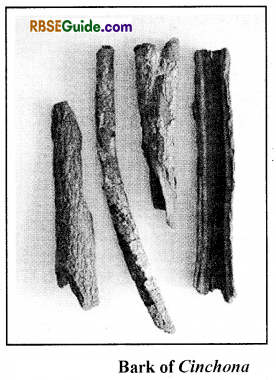
Plant
- The plant is an ever green medium sized tree or shrub (16’40′). The leaves are large sized and simple, opposite, laneolate and 10-40 cm long.
- Inflorescence is terminal compound raceme (Panicle) with small, white or pinkish red coloured flowers.
- The fruit is capsule containing numerous seeds.
- The bark of stem of Cinchona tree contains quinine alkaloid in highest amount. The bark is peeled out. dried and the useful medicine is extracted.
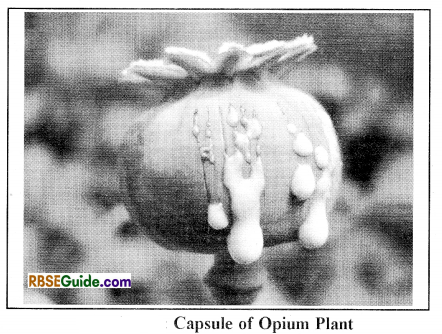
- More than 30 types of alkaloids have been identified from the bark of different species of Some of these are: Quinine, Quinidine, Cinchonine, Cinchonidine etc.
- Some minor alkaloids found are Cinchotine, Hydroquinone, and Quinamine etc.
Medicinal Uses
- Quinine is most effective and extensively used medicine of Malaria. It targets the schizont stage of the parasite (Plasmodium vivax).
- It is useful in treatment of pneumonia and amoebic dysentry.
- It is also used as tonic and antiseptic.
- It is used in treatement of arthritis and tonsilites.
- Indiscreminate use of quinine may induce deafness, letharginess, vomiting and blindness. In women it may result in abortion or miscarriage.
Asafoetida, Devil’s dung
- Local name- “Heeng”
- Botanical name—Ferula asafoetida
- Family—Apiaceae, (Umbelliferae)
- Useful plant part—Oleoresin gum secreted from root tubers
Origin and Production
- Heeng plant is cultivated in Afganistan, Baluchistan, Iran, Pakistan and India (Jammu & Kashmir).
Plants
- The plant is small sized perennial shrub. The stem is erect with large leaves which are dissected.
- The roots and root tubers are conical inshape like carrot.
- Infloresence is umbel with unisexual and bisexual flowers. The flowers are small and dirty yellow coloured.
- Fruits are thin, oval, reddish brown cremocarp.
- For obtaning asfoetida (Heeng) one year old plant is cut near the ground and from the cut end the oleoresin gum is secreted from the root tuber part. This becomes commercial heeng on drying.
- Chemical composition
- The commercial asafoetida is yellow brownish semi dry or dry, acellular oleoresin gum.
- It tastes bitter and has strong odour.
- Asafoetida does not contain any alkaloides.
- Besides resin, it contains, gums, essential oils such as Pinene, Umbelliferin, Ferulic acid. The strong and Alliaceous odour of asafoetida is due to pinene and the bitter taste is due to ferulic acid.
Medicinal Uses
- Heeng is anthelmintic, Antispasmodic, Aphrodisiac Carminative Diaphoretic, Digestive, Expectorant, Laxative, Diuretic and Stimulant.
- Asafoetida is used in chronic bronchitis, colic ache, tooth ache, indigestion, abdominal inflamation, epilepsy etc.
- Several Ayurvedic formulations are prepared using asafoetida as an important component.
- It is also used extensively as condiment.
Turmeric
- Note : Turmeric (Curcuma longa) has been dealt in details under the head spices earlier in this chapter as (18.3.3)
![]()
Some of Medicinal Plants and their uses found in Rajasthan
| S.No. | Common Name |
Botanical name | Family | Important Plant Part | Medicin al Uses |
| 1. | Ashwagandha Asgandh |
Withanica somnifera | Solanaceae | Roots | Invigorating/tonic, ligament weakness |
| 2. | Satavar | Asparagus racemosus | Liliaceae | Roots | Tonic |
| 3. | Safed Musli | Asparagus adscendens Chlorophytum bormlianum |
Liliaceae Liliaceae |
Roots | Tonic |
| 4. | Arjun | Terninalria arjuna | Combritaceae | Stem Bark | Heart diseases. |
| 5. | Neem | Azadirachta indica | Meliaceae | Bark, leaves | Enhances immune svstem |
| 6. | Brahmi | Centella asiatica | Apiaceae | Leaves | Memory booster |
| 7. | Guwarpatha | Aloe Vera | liliaceae | Leaves | Body tonic, skin care |
| 8. | Tulsi | Ocimum sanctum | Lam iaceae | Leaves | Coughing, fever |
| 9. | Sona mukhi | Cassia angustifolia | Caesalpiniaceae | Leaves | To treat constipation |
| 10. | Guggul | Commiphora wight | Burseraceae | Secretions of stem | Arthritis and obesitv treatment |
